Portrait of a Cruiser: Kerstin and Martin Giretzlehner
Kerstin and Martin Giretzlehner fell in love with the sailing life after their first crewed charter in Croatia in 2011 and spent the next few years learning all they could while chartering in the Mediterranean and the Canary Islands. In 2020 they took the plunge, bought a catamaran and set off from Trogir, Croatia on their circumnavigation. They are currently in French Polynesia planning their next westward move.
Published 3 years ago
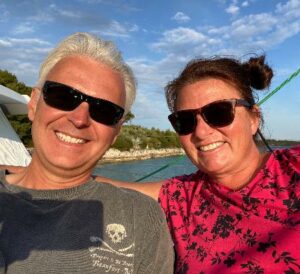

Nationality: Austrian
Boat Name: Infinity
Boat Type: Fountaine Pajot Lucia 40, 4 cabin versión with 2 bathrooms
Home Port: Vienna
Blog: http://www.sailing-infinity.net
How did you start cruising?
I (Martin) did some sailing as a kid in school on Austrian lakes, but more or less we were complete novices before we started in 2011. Our first experience was with a crewed charter in Croatia to learn all about sailing.
Our Charter Skipper Nikola Krsanac was a great guy and so we learned fast and he prepared us for the Croatian sailing license. From then we were infected with the sailing virus.
After that first experience, we chartered each year for some weeks in the Mediterannen and Canary Islands to learn. In our opinion it is crucial to get to the point where you take responsibility of a boat and crew quickly without a professional skipper. You will make mistakes, but you will have a steep learning curve. We wanted to learn more and so we undertook further trainings for safety and catamarans in Austria and Italy. Also we made further sailing licenses in Austria.

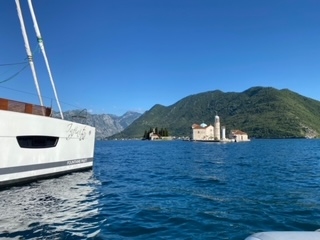
- Infinity anchored off Montenegro.
Mainly we sailed small monohulls with a crew from two to five in Croatia, Greece and on the Canary Islands. The first time we chartered a catamaran in Croatia we were convinced that this would be the best mixture between comfort and sailing for us as you can eat and live like humans even in high waves under way.
We went to see some catamarans in a size which we could afford. We went to Boat Shows in Tulln, Düsseldorf, La Grande Motte. Also we had been advised by Charter Companies about the strengths and weaknesses of different types of catamarans. A salesman in France told us, that Pitter yacht charter in Croatia has an excellent reputation in maintenance of their fleet and so we went to see Klaus Pitter. Pitter yacht charter bought the boat with the features we wanted with their buy charter model. It was fully booked for two seasons in Croatia and earned back a significant amount of money. Also we could sail with it and it was well maintained.
In 2020 we bought the boat out of the charter model, did some preparations with the Pitter Crew in Trogir like water maker, heating and some upgrades and set out on our circumnavigation. We would do it like this again.

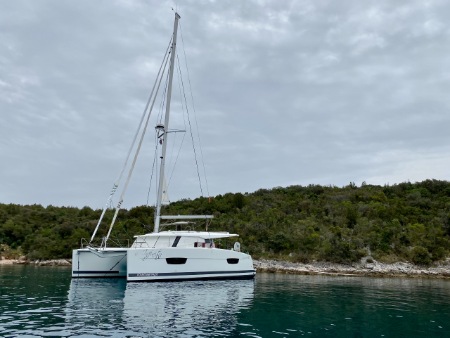
- Infinity anchored in Croatia, close to Trogir.
Described what sort of cruiser are you?
We are a live aboard couple. We still have our house in Austria which is rented out. We have been retired for some years as we didn’t want to have pressure on the journey. This is very important for the safety of the journey for us as we will only sail in suitable weather windows.

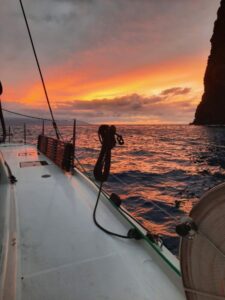
- Crossing the Atlantic.
What type of cruising are you doing currently?
We are on our circumnavigation which started from Trogir, Croatia in May 2020 after the Covid lockdown.
What were the key reasons you selected your current boat?
We wanted a catamarán as we cruise the coconut milk run and wanted to have a high quality of living on board. A new catamarán with 4 cabins promised the highest profit during chárter. The Lucia 40 was one of the catamaráns in the affordable price range for us at the time we bought the boat. Lagoon 40 was not launched yet and Lagoon 400 was to old school for us. Delivery of Leopards from South Africa is expensive and Bali was not long enough on the market to be able to rate the quality of their boats. Buying with a serious charter Company like Pitter Yachting offers bigger discounts from the yard and gives you revenues to lessen the price. Also the boat will be better than new after two seasons of charter as everything that breaks will be repaired then. And you can experience your own boat in a charter setting with technical support for some seasons. We would do this again.
What other boats have you owned?
None – Infinity was our first boat.

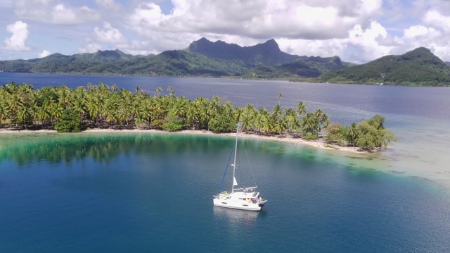
- Infinity anchored in Raiatea, French Polynesia
What changes have you made to your current boat?
Watermaker, more solar power, option furling main sail, isolation transformer, 1500 W anchor winch, freezer, energy monitor.
Most useful equipment fitted, and reasons for this choice:
Watermaker (30 l) you can run by solar power, 400 W solarpanels for energy, small portable generator – energy for more cloudy days in a row, energy monitoring system to know how many amps go in and out.
Equipment regrets, or things you would do differently:
Escape hatches always leaking. There is no customer support from Fountaine Pajot. They don’t answer mails and don’t answer phone calls…

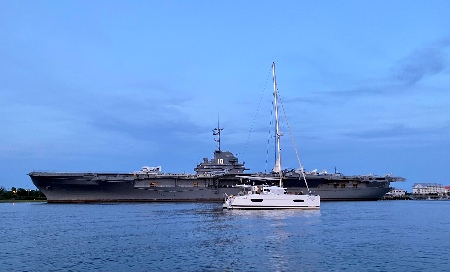
- Infinity in Charleston, USA in front of the USS Yorktown.
List the countries you have cruised:
Greece, France, Spain, Italy, Croatia, Montenegro, Albania, Barbados, Sint Maarten, St. Lucia, Martinique, Guadeloupe, US Virgin Islands, Puerto Rico, USA, Bahamas, Cuba, Panama, Galapagos, French Polynesia, to be continued…
Future cruising plans:
New Zealand, Indonesia, Malaysia, Thailand, South Africa…

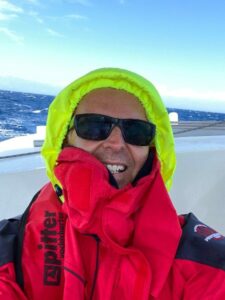
- Sailing in the Atlantic Ocean.
List the oceans/seas you have crossed:
Mediterranean, Atlantic, Caribbean Sea, Panama Canal, Pacific Ocean.
Approximate sea miles:
18, 000
Scariest day on the water
Water coming in through the escape hatches at night in Cuba in heavy seas. The escape hatches were renewed on the Canary islands and failed some months later. They are just bad quality.
From Marina Hemingway in Cuba we headed to Maria La Gorda – a huge bay in southwest Cuba with great dive sites. Most of the route is downwind and accordingly pleasant sailing. The last stretch after the southwestern tip of Cuba is upwind and less pleasant. The waves crash violently against the ship.
Around this cape there are magnetic anomalies and wild currents with accompanying waves. It is not without reason that hundreds of Spanish sailing ships from previous centuries are grounded here. We planned to arrive at sunrise. During his night watch, Martin suddenly hears a strange noise coming from the starboard hull. As he climbs the steps into the fuselage, he already notices the misery. With every wave, a splash of water comes through the escape hatch and sometimes splashes across the ceiling. Part of the hatch seal was displaced inward by the force of the oncoming waves. The bilge is continuously full with 5 cm of water.
We switch to crisis mode and try different courses to the wind at different speeds. Every effort is made to minimize the ingress of water. Bringing a gel-like sealant with you is of no use as it cannot withstand the pressure. We don’t want to open the hatch to be able to slide the seal back again, since an incoming wave with the hatch open would bring in significantly more water than the many splashes through the displaced seal. Kerstin tries to seal the hatch with chopping boards and towels while Martin positions the pumps. The pumps work, but they don’t deliver any water, since the water level would have to be higher for the pump to get no air when it’s rocking. With reduced speed and the provisional sealing tests, almost no more water enters.

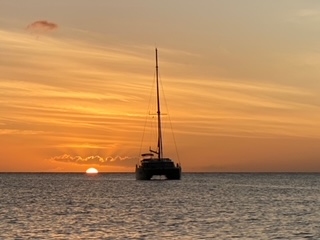
- Sundown in the Canary Islands.
We do not give an emergency signal, as there is currently no danger to the ship or life. Kerstin takes the water out of the bilge with a sponge and buckets. After three hours we arrive at the anchorage at sunrise and are informed by radio that we should moor to a buoy. Completely exhausted we fall into bed. We can absolutely confirm the often quoted blue water sailor proverb: “Blue water sailing means to repair the ship in the most beautiful places in the world.”
The escape hatches on a catamaran are designed to make it easier to exit in the event of a capsize. They are on the waterline. We would prefer a ship with no escape hatches, but this is a worldwide “safety standard”. The ratio of capsized catamarans compared to the problems these escape hatches pose to all non-capsized ones doesn’t come close to justifying such huge glassed-in waterline holes for us. On top of that, we had these escape hatches replaced last year due to a shipyard recall because the previous hatches posed a safety issue due to a design flaw.
For once, we don’t see a huge improvement in the new escape hatches. After all, the glass no longer falls out as was supposedly the case with the old ones. The next day we clear out the entire bilge. Everything is rinsed with fresh water and the bilge is cleaned. So you can also spend beautiful days in a beautiful bay. The seal is glued in such a way that it can no longer be flushed out. We also take the opportunity to check the escape hatch opposite and find that the seal’s adhesive is no longer holding at one corner. Who actually makes something like this? We extend the mantra that our sailing instructor from France gave us “Beware of the fishermen!” with “Beware of Goiot-hatches!”
Best cruising moment:
Arriving in Barbados after our first Atlantic crossing.
Favorite Anchorage:
Apataki in the north east corner of the Tuamotus in French Polynesia. It is very remote and calm. There are no inhabitants at this corner and there is crystal clear water with turquoise and blue colors. The sandy beaches seem untouched and palm trees cover the atoll.

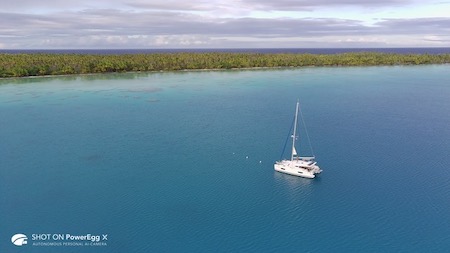
- Apataki, French Polynesia.
Favourite cruising apps:
Boating Navionics.
Favourite cruising websites:
Noonsite and www.blauwassersegeln.de.
Favourite cruising books:
Taipi from Herman Melville. Taipi describes the life of a crew member of a whaler in the past centuries. When they came to the Marquises two crew members escaped the ship and lived with the native people. I read the book while being on the Marquises. The author Herman Melville sailed on a whaler and was on the Marquises, which gives the story its authentic touch.
What advice or message would you want to pass on to anyone new to cruising or thinking about casting off the dock lines?
Just do it. Living aboard is less sailing but more project management and repairing stuff.
Of course to cast off is not easy and seems more complicated than the sentence “just do it“ but in the end after all preparations and pros and cons it is all about casting off or staying at home.
At this point it is essential to simplify the complex project and dare just to start – just to do it. Many unanswered questions will be answered on the way and many problems will be solved under way.
Fatty Goodlander simplifies in one of his books that you can buy and sail a ship when the air stays inside and the waters stays outside the hull, the mast is up and the keel is down. I agree with that as sailors have managed to sail for millenniums without complex stuff on board.
Bobby Schenk simplifies in one of his books, that a crossing is not not complicated. Starting from Europe, just sail to the Canary Islands in September, ask your boat neighbors all the questions you still have and sail to the Caribbean in December. Under way you will learn the rest. Even if you drop a piece of wood into the sea on the Canary Islands, it will show up in the Caribbean after some time driven by wind and current without sails or helm.

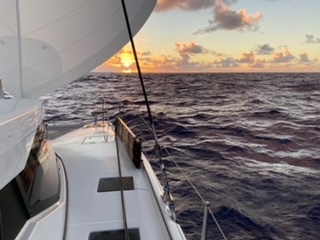
- The Atlantic Ocean
I have read many books and was prepared for a huge amount of maintenance and repairing. Still I did underestimate this amount. Even we started with a boat being only two years old, work, maintenance and repairing, formalities, research, routing, weather routing, being under way etc. is about 3 to 5 days a week. The rest of the week is spare time. The work – leisure balance is not far from a full-time job at home. Of course being your own boss and being able to sail and travel might be more motivating for most of the sailors, than doing a 9 to 5 job on land.
Why cruise? In a few sentences, what is it that inspires you to keep cruising?
Explore new countries and meet happy people – this is what keeps us going: making new friends and explore the beauty of islands and countries from a sea perspective. Also we are divers and like to explore sea life. Of course there are some moments when stuff breaks or in bad weather when you think about if living on a boat is worth all of the hassle. But in the end it just takes a few beautiful days at sea or on land to forget about all the hassle.
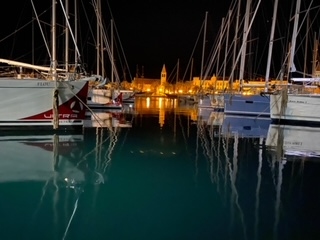

We were also liveaboards during the Pandemic and were stuck in Trogir, Croatia, for some weeks. Even at this time we made new friends and visited many places in Croatia, Montenegro and Albania after the lockdown. Infinity was the only boat in most of the bays which was very rewarding. On the other hand we couldn’t stop everywhere we wanted and it was difficult to fulfill all the Covid requirements in different countries. Noonsite was very helpful with the “Biosecurity” knowledge base.
Any other comments:
Thank you Noonsite.
Also, if you buy a catamaran, take good care of the escape hatches. Have them serviced like your rig or your engine as these are big holes at the waterline. If they fail, you will be in serious trouble not only if the catamaran capsizes.
Collecting rainwater helps a lot for saving energy of the Watermaker and works easily with self-made reversed plastic bottle collectors with attached hoses from the roof of a catamaran where the most water will flow when it is raining.
Circumnavigation is less about sailing and more about project management and repairing stuff.
Kerstin and Martin Giretzlehner
SV Infinity
………………………………………………………………………………………………………………………………………..
Related Content:
More Portrait of a Cruiser stories.
If you think you have an interesting story to tell and would like to take part in our Portrait of a Cruiser series, please contact Sue at editor@noonsite.com for a questionnaire.
………………………………………………………………………………………………………………………………………..
The opinions expressed in this article are the author’s own and do not reflect the view of Noonsite.com or World Cruising Club.
Related to the following Cruising Resources: Circumnavigation, Portrait of a Cruiser

